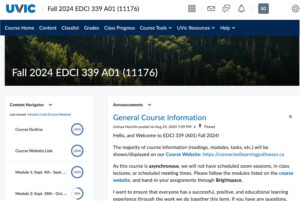Blog Post #2
Pedagogy
Pedagogy refers to the methods and means used in teaching. For me, it represents the ways in which teachers effectively share knowledge and skills with students. Reflecting on my own learning experiences, I gained the most from activities that encouraged active participation, such as engaging in discussions and working with peers. Personally, I enjoy a mix of guided instruction alongside open-ended discussions that encourage critical thinking. For example, role-playing in the case study scenarios greatly deepened my understanding of the course material. In addition, I believe that pedagogy should take into account the diverse needs of learners, as different students thrive through different approaches. In the future, I plan to focus on learning methods that align with my personal learning style.

Networked Pedagogy

Networked pedagogy highlights the crucial role of social interaction and collaboration in the learning process. It enhances learning by fostering connections between individuals and making shared resources easily accessible. By participating in online group discussions through platforms like social media or virtual meetings, I’m able to engage in meaningful conversations, exchange ideas, and work on group projects, regardless of time or geographical barriers. This makes learning more flexible and dynamic. Technology plays an essential role in supporting networked pedagogy by offering tools such as Zoom, Microsoft Teams, and various social media platforms that enable seamless interaction and collaboration across different locations. These technologies break down traditional barriers, making learning more flexible and collaborative.
Learning Theories in Practice – Connectivism
There are many frameworks that explain how people learn, and connectivism is one of them. Below is a video that introduces connectivism and provides more details about this learning theory:
Connectivism, a relatively new learning theory, resonates with me because it aligns closely with how we learn in the digital age. It emphasizes learning as a process of connecting specialized sources of information and forming networks. In an online environment, connectivism manifests through the use of various social media, online forums, and collaborative tools that enable learners to access and share collective knowledge. I can see this theory shaping my approach to learning by encouraging me to take advantage of the redundant online information. It also motivates me to seek out connections between different sources of knowledge and engage with individuals who bring varied expertise.
The Role of Instructors
In an online course, the instructor’s role shifts from being primarily a content deliverer to becoming a facilitator of learning. This transformation requires instructors to embody qualities such as clear communication, empathy, flexibility, and technological proficiency. A key part of their role is to create an environment where students feel supported and engaged, despite the lack of in-person interaction. Good instructors need to be approachable and responsive, offering timely feedback and answering questions promptly, to help build a sense of connection. Although I only started online courses this term, I’ve appreciated the flexibility they offer. While different instructors may have varied teaching styles, they all made efforts to keep students on track through tools like discussion forums, emails, announcements, and Zoom office hours.
Here is how the University of Oklahoma describes the role of instructors: The Role of the Instructor in Online Learning. It describes the instructor’s need to initiate interactions regardless of the format of teaching. It also explains four different roles instructors take to facilitate such interactions.
Exploring Digital Spaces
The digital space provides numerous advantages for learning, including greater accessibility, flexibility, and the opportunity to connect with a broader audience. UVic Brightspace is an example of a digital space where learning takes place. I’ve appreciated the chance to take online courses, allowing me to learn at my own pace, participate in forum discussions, and access diverse resources beyond traditional textbooks. However, digital learning also comes with its challenges. Distractions, potential miscommunication, and the absence of face-to-face interaction can sometimes create a sense of isolation, making it harder to stay engaged. Balancing these benefits and challenges is key to making the most of online education. To ensure that I am contributing positively to digital communities, I aim to be respectful, supportive and engaged. This means providing respectful feedback, sharing useful resources, and participating actively in discussions. By doing so, I hope to foster a collaborative environment for others.


